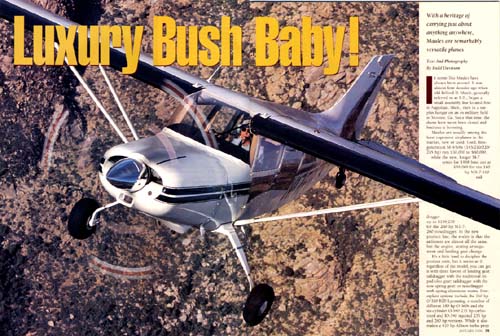
PIREP: Maule M-7-235C
(1998 Model)

Love 'em or leave 'em. That seems to be the Maule's long term status in life. People either love them or spend undue amounts of time bad mouthing them. Of course, the usual answer when a pilot is asked how they feel about a Maule is, "What's a Maule?"
The Maule has always just been "there." Old Belford D. Maule, generally referred to as "B.D.", may not have built the classiest, fastest or most finely fitted airplane in the business, but the doors to the funky little assembly line located first in Napoleon, Michigan, then in a military surplus hangar on an ex-military field in Moutrie, Georgia have never been closed. B. D. recently passed away, leaving the family owned business in the hands of the rest of the Maules and it seems to be prospering.
Maules are usually among the least expensive airplanes in the market, new or used. Used, first generation M-4/5/6's (145/210/220 hp, 235 hp) run $30-$60,000 while the new, longer M-7 series for 1998 base out at $99,069 for the 160 hp MX-7-160 taildragger up to $159,278 for the 260 hp MT-7-260 nosedragger. In the new product line the reality is that the airframes are almost all the same, but the engine, seating arrangement and landing gear change.
It's a little hard to decipher the product code, but it seems as if, regardless of the model, you can get it with three flavors of landing gear: Taildragger with the traditional tri-pod oleo gear, taildragger with the new spring gear or nosedragger with springmains. Powerplant options include the 160 hp 0-320 B2D Lycoming, a number of different 180 hp 0-360's, and the six cylinder 0-540 in both carburated and injected 235 hp and 260 hp versions.
Sharp observers will notice we've neglected to mention the screamer of the line, the 420 hp, Allison turbo prop version. Since it starts at $450,000, we didn't think it applied here.
All of this information was rattling around inside my head when the phone rang and Frank Ramsey from Scottsdale, AZ asked me a leading question: Although he was already qualified in the airplane, would I be willing to ride with him and sharpen his skills in his brand new Maule? Silly question. Eventually we spent nearly 15 enjoyable hours together, mostly in the pattern, poking into the airplane's darkest nooks and crannies.
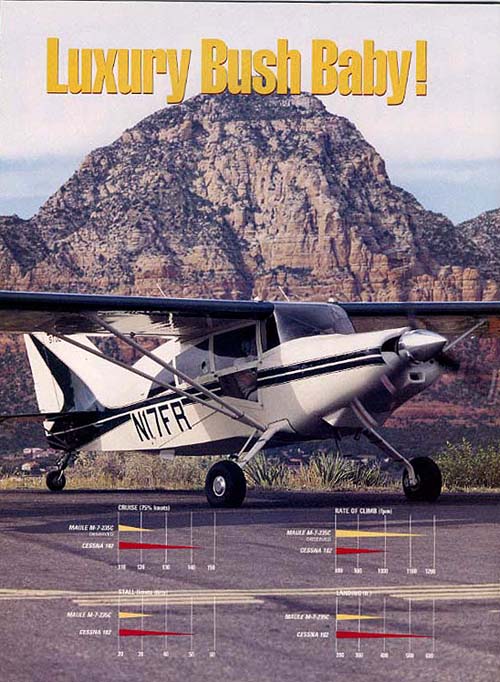
The first time I walked up to the airplane, I immediately noticed some major differences between it and past Maules I'd examined. For one thing, the exterior finish was drastically improved from years past. More important, the way things fit together was even more improved. The leather interior bordered on being luxurious. Some Maules in the past have had a less than professional appearance, but not Ramsey's M-7-235C. It compared favorably with the best of them.
A note about what appears to be a huge number of seats in Ramsey's airplane: Yes, you can seat FIVE people (assuming the rear one i on the small side), but you can't fly with them. Not for more than a few minutes anyway. Even though it is a "bush" airplane, the useful load is only 900 pounds (827 pounds in Frank's airplane because of the float kit, avionics, etc.), so you have to be judicious as to what you use that weight for. With 73 gallons of fuel in two outboard aux tanks and two inboard mains, it doesn't take much math to realize two FAA sized pilots in the front seat put the airplane right at its gross of 2,500 pounds. In fact, with all four seats filled with 170 pound people and no baggage, you wind up with 1.5 hours of fuel to flame-out. As you start converting people to fuel, however, the numbers get much better. For instance three adult males with 43 pounds of baggage have 3.5 hours total fuel.
It goes without saying that those using the airplane seriously in the bush have a rather loose attitude towards the established limits or they fly short legs.
November 17 Foxtrot Romeo (17 was Frank's number when flying 0-2's as a FAC in Vietnam. He also flew a 'Nam tour as A/C in B-52's) is equipped with the massive spring gear option. The gear looks good, but Frank had found that the airplane was light enough in the tail that abrupt use of brakes at even taxi speeds could lift the tail. Ramsey says the spring gear positions the mains further aft than the oleo gear does, so we plopped a bag of bird seed into the back seat, for insurance.
Saddling up, I was pleased to see the front seats had bungee assists to help slide them uphill to the forward position, which was necessary for my thoroughly average body and leg-length. I can't imagine a pilot being too tall to fit the airplane. At 5'10", I was sitting high enough the nose only covered the center of the runway with nearly half of it visible around the nose and I had a huge amount of headroom left.
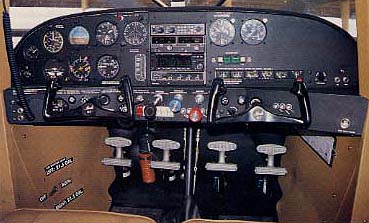
The panel is obviously big enough for anything electronic, because that's what Frank had stuffed in his panel...everything. The arrangement is standard but there are some weird anomalies. For instance, the avionics master is clear to the right under the co-pilot's yoke. Also, the airplane had a vernier throttle which Frank understands is standard for any of the six cylinder airplanes. After a few hours in the pattern, we decided verniers don't make sense in a bush airplane and Frank had it replaced with a standard push-pull throttle.
The instant the 235 hp Lycoming lit off, the six cylinders worked with the optional three blade McCauley prop to produce an extremely smooth running combination. In fact, that was one of the very nice parts of the airplane. At any power setting, in any situation, it was super smooth.
On the first takeoff, it became obvious why the airplane is touted as a STOL bird. 24° of flap is normally used (two notches, as the flaps stow at a minus 7°, with the handle down, making the first notch 0°). The takeoff happens so quickly it would be hard to get in trouble. Yoke full aft, power in and just relax back pressure. Incidentally, it loses about 15° of up elevator deflection if you stop pulling at the point where the yoke starts traveling up into your face. The airplane only rolls a short distance before the tail blows itself off the ground. It races ahead maybe another 200 feet then dances around on it's mains, all ready to fly, unless you tighten up on the yoke and lift it off. Maintain a slightly tail-low stance and it will blast off the runway as if it has someplace to go. The bottom of the white arc is 40 mph, but on takeoff you can't look down fast enough to catch it under 55 mph.
Directional control during takeoff consists of just a little rudder pressure one way or the other to keep the nose from moving. If there's no crosswind, it tracks amazingly straight and gyroscopic forces turn it left only if the tail is yanked into the air in a hurry. If there's a strong crosswind, however, especially a left one, expect it to try to weather vane.
I have to admit to being disappointed initially with the airplane's climb performance. We were two guys in a high powered airplane and I'd expected more than the 1,100 fpm the VSI showed. Of course, I'd forgotten the temperatures were putting us at a density altitude of around 5,000 feet and we always carried full fuel so we were at gross. Then, we flew up to Payson (5,000 feet MSL, 7,500 feet density altitude) and shot a bunch of touch and goes. We showed 1,100 fpm on takeoff. Then we loaded Frank's wife Janice and The Arizona Red Head in the back and took off for Sedona, 4,700 feet MSL. We showed 1,100 fpm coming out of there too. In the course of flying the airplane in virtually every possible operating environment, it didn't seem to care how much it was carrying, how high we were or how hot it was. It always climbed at 1,100 fpm which ain't bad!
Where the altitude difference did show up, however, was takeoff run. With four inches less manifold pressure at the higher altitudes, it sometimes took as much as 700-800 feet to get off the ground, where at 1,500 feet MSL we routinely did it in half that.
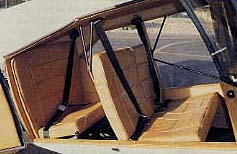 Incidentally,
those big side windows are worth every dime, as they not only
lighten up the cockpit, but the improvement they make in sight
seeing visibility is not to be believed. On the way to Sedona
I spent a lot of time pointing out Indian ruins and the windows
really worked. I did notice, however, that when maneuvering low
and steep, visibility into the turn was severally limited by being
seated so far behind the wing's leading edge. The optional sky
lights might have helped that.
Incidentally,
those big side windows are worth every dime, as they not only
lighten up the cockpit, but the improvement they make in sight
seeing visibility is not to be believed. On the way to Sedona
I spent a lot of time pointing out Indian ruins and the windows
really worked. I did notice, however, that when maneuvering low
and steep, visibility into the turn was severally limited by being
seated so far behind the wing's leading edge. The optional sky
lights might have helped that.
The pilots operating handbook (POH) doesn't have a single performance chart of any kind in it, so we guessed at cross country power settings. At 20" and 2,300 rpm (about 60%), for instance, we were truing 116 knots at 12.5 gph at 6,500 feet, leaned just short of peak. Bringing the power up to 22" only added about three knots at the expense of another gallon of gas. Dropping down to 18" gave up over six knots and saved only about a gallon. After looking at the Lycoming power charts, because Maule doesn't issue any, I'm now doubting the accuracy of Frank's fuel flow meter, as Lycoming says we should have been burning 10-10.5 gallons at those power settings and altitudes.
A note here: The maneuvering speed is 107 knots and isn't marked on the airspeed indicator, so it's a good idea to slow down when the bumps get bad.
Frank had been checked out at the factory when he took delivery of his airplane, so he carried with him all of the landing techniques which the boys at Maule have worked out over the past 35 years. For the most part, we stuck to those guidelines, but investigated on either side of the numbers just to see how the airplane reacted.
The first trip down final was an interesting experience because I didn't expect the airplane to need so much attention to maintain a given airspeed. I also didn't expect it to require such accurate airspeed control. Frank said the factory advised 65 mph for a normal approach and 58-60 mph for a short approach. We used full flaps, 48°, in almost all approaches . Using less flap for a crosswind moved the approach speed up to 70 mph.
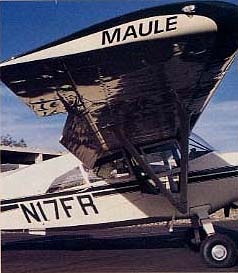 As
I played with the airplane, I found it changed personality twice
in the speed band between 60 mph and 70 mph. At 68-70 mph, it
was a floater and demanded getting all the power off to let it
land. At 64-66 mph, it had a moderate float and might need a touch
of power in the flair, but usually not. At 60-62 mph, you'd better
be right there with the throttle all the way through flair because
power-off, it had no ground effect at all and would flop onto
the ground like a dead flounder, if you'd let it. Reducing flaps
to 40° didn't seem to change anything. Bear in mind, these
are not criticisms as much as recognizing specific characteristics.
As
I played with the airplane, I found it changed personality twice
in the speed band between 60 mph and 70 mph. At 68-70 mph, it
was a floater and demanded getting all the power off to let it
land. At 64-66 mph, it had a moderate float and might need a touch
of power in the flair, but usually not. At 60-62 mph, you'd better
be right there with the throttle all the way through flair because
power-off, it had no ground effect at all and would flop onto
the ground like a dead flounder, if you'd let it. Reducing flaps
to 40° didn't seem to change anything. Bear in mind, these
are not criticisms as much as recognizing specific characteristics.
Of equal interest was that in the area of 70 mph, it didn't want to give up speed very quickly. However, as it came down around 65 mph, it was all too willing to shed mph and you had to watch it constantly to keep from getting too slow. "Too slow" in this case was 60-62 mph.
If you're an "attitude flyer" and are used to watching the nose, holding the speed isn't really difficult because that long nose announces what's about to happen to the speed. If you don't fly the nose, you have to keep a close watch on the airspeed as it will change in a heartbeat.
For the first and only time in nearly 35 years of instruction, I told a student to check the airspeed on short final, rather than just holding a nose attitude. Being new to the airplane, Frank wasn't super-aware of subtle changes in the nose attitude, so he had to be aware of the airspeed to know how the airplane was going to react when he finally did flair.
The up-side to this kind of short-final manners is that in the area of 60-62 mph subtle movements of the throttle let you plant the airplane on a given point every single time. Also, the power-off angle of descent at 60 mph is so steep and easily controlled, you could drop over a tree line without ever having to drag it in on power. However, right as you start to flair in that situation, the throttle becomes a serious necessity to arrest the rate of descent.
Just as an aside: The Maule is a lousy slipping airplane.
On roll-out the airplane has some "interesting" characteristics. None of them are bad, but they are all worth noting. The first characteristic is that it is about as directionally stable as any tailwheel airplane ever built. It needs minimal attention. That huge tail, however, does make it a little more sensitive to crosswinds than some airplanes, so the pilot has to stay awake. He also has to be aware that in even the slightest hard turn, you can hear the tires protesting because the gear is so stiff it isn't giving and all sideload is transferred to the tires. If a slight swerve develops, or the airplane is planted on crooked, it is very willing to lift the inside wheel, something I've seldom seen in thousands of hours of tailwheel instruction. The event is fairly subtle and is happening slowly so the pilot has all day to correct it, but it requires aileron into the turn to put the wing down which is opposite to many pilots' instincts.
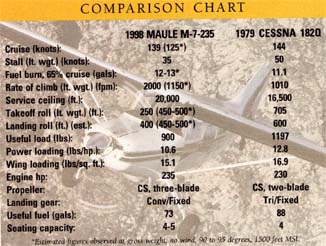
Another semi-strange thing happened when I was flying it in a switchy little 7 knot, 90° crosswind. I'd touched down and it tried to turn into the wind. I put in rudder, then more rudder. Soon, the rudder was against the floor but the airplane was still turning left. Since everything was happening so slowly, just for the heck of it I let it continue to see if the rudder or tailwheel would catch it. They didn't and I had to tap the right brake which straightened it out immediately. The demonstrated crosswind component of the airplane is only 12 knots, which is probably conservative, but it does require some pilot attention in that area.
As I mentioned, everything during the landing is happening in super slow motion and it decels quickly so it's easy to keep up with the airplane.
I have to admit that initially I was underwhelmed by the airplane, but the more we flew it, the more I grew to like it. Yes, it demands some attention on short final, but that's what flying is all about anyway. And yes, it would benefit from a larger useful load, but if the pilot is flying heavy loads into the bush, it's usually a short haul and it takes only minutes to remove all the seats giving a huge cargo bay. The airplane was really quite comfortable on cross country and passengers love the big windows. A real plus is that, as tailwheel airplanes go, this is one of the easiest to handle but speed control is critical.
Would I buy one, if I had the money? If I was in the market for a new four-place taildragger, I'd have to say I probably would as there aren't many choices. Now, does anyone out there want to loan me the money? BD